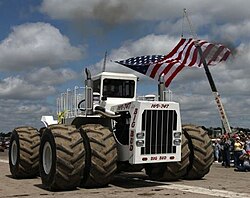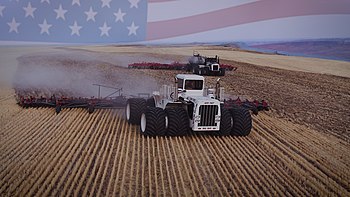Big Bud 747


The Big Bud 747 or 16V-747 Big Bud is a large, custom-made farm tractor built in Havre, Montana, in 1977. It has 1100 horsepower. It is billed by the owners and exhibitors as the "World's Largest Farm Tractor".[1] It is about twice the size of many of the largest production tractors in the world, depending on parameter.[2]
History[]
The first two Big Bud tractors out of the Havre, Montana plant were the 250-series and were purchased by Leonard M. Semenza of Semenza Farms in 1968 located between Fort Benton, Montana, and Chester, Montana on his 35,000 acre farm. The 747 tractor was originally designed by Wilbur Hensler[citation needed] and built by Ron Harmon and the employees of his Northern Manufacturing Company,[1][3] at a cost of $300,000.[3] It was made for the Rossi Brothers, cotton farmers of Bakersfield[1] or Old River, California.[3] It was used there for eleven years; it was then purchased by Willowbrook Farms of Indialantic, Florida. Both farms used it for deep ripping.[1]
In 1997, after a period of disuse, it was purchased by Robert and Randy Williams,[4] of Big Sandy, Montana, within 60 miles (97 km) of where it was built. It was used on the Williams Brothers' farm in Chouteau County to pull an 80-foot (24 m) cultivator, covering 1.3 acres (0.53 ha) per minute[4] at a speed up to 8 miles per hour (13 km/h).[1]
The United Tire Company of Canada, which made the tractor's custom 8-foot (2.4 m) tires, went bankrupt in 2000, partially contributing to the decision to stop using the tractor for regular work in July 2009,[3] and to move the Big Bud 747 to museums.[4]
After its work on the farm, it was displayed at the Heartland Acres Agribition Center in Independence, Iowa. In 2014, the Big Bud 747 was moved to the in Clarion, Iowa, on indefinite loan from the Williams Brothers; the museum constructed a separate shed for the tractor in 2013.[4]
On July 14, 2020, the Big Bud's original eight-foot tall construction tires were replaced with Goodyear LSW1400/30r46 tires (which are slightly under seven feet tall),[5][6] with new rims provided by the Williams Brothers to fit them. The new tires brought the width of the Big Bud to just over 25 feet.
The Big Bud 747 returned to the Williams Brothers farm near Big Sandy, Montana, in September 2020, where it worked farm ground once again with an 80-foot wide FRIGGSTAD chisel plow.[7]
Statistics[]
General[]
- Height: 14 feet (4.3 m) to top of cab[1]
- Length: 27 feet (8.2 m) frame; 28 feet 6 inches (8.69 m) to end of drawbar
- Width: 13 feet 4 inches (4.06 m) over fenders; 25 feet 6 inches (7.77 m) over duals[clarification needed][1]
- Wheelbase: 16 feet 3 inches (4.95 m)[1]
- Tires: 8 feet (2.4 m) in diameter;[1] 39.6 inches (1,010 mm) in width;[3] (38 x 35 16 ply duals)[citation needed]
- Weight: 95,000 pounds (48 short tons; 95,000 lb) shipping weight;[1] over 100,000 pounds (50 short tons; 100,000 lb) when 1,000-U.S.-gallon (3,800 l; 830 imp gal) tank is full;[1] 135,000 pounds (68 short tons; 135,000 lb) fully ballasted[3]
Tank capacities[]
- Fuel capacity: 1,000 gallons (diesel fuel)[3]
- Hydraulic reservoir: 150-U.S.-gallon (570 l; 120 imp gal) tank[1]
Engine[]
- Detroit Diesel 16V92T: 16-cylinder, two-cycle engine[3]
- Power: originally 760 horsepower (570 kW), but later increased to 860 horsepower (640 kW), then to 960 horsepower (720 kW)[3] but is now at 1100 hp
- Displacement: 1472 cid (24.1 L), or 92 cid (1.5L) per cylinder[3]
- Induction: 2 turbochargers, 2 superchargers[3]
- Starter: 24 volts;[1][3] all other electrical is 12 volts[3]
- Alternator: 75 ampere[1]
Transmission[]
- Forward speeds: 6[1][3]
- Reverse speeds: 1[1]
- Torque: 3,100 pound-feet (4,200 N⋅m) at 3401 rpm[citation needed]
Other[]
- Cab features: Air conditioner; heater; windshield wipers; swivel bucket seat plus buddy seat; AM/FM radio; 8-track stereo system (made in 1977).[citation needed]
Comparison[]
For perspective, many of the largest production tractors such as the John Deere 9630 are about half the horsepower,[8] less than half the ballasted weight,[9] and often use a more standard six cylinder class 8 truck engine.[10] By the 2020s there were several new tractors over 600 horsepower but still weighing much less, including the 700 horsepower Fendt 1167 with a low rpm engine.
References[]
- ^ Jump up to: a b c d e f g h i j k l m n o p "16-V 747 Big Bud "The World's Largest Farm Tractor"". Big Sandy, Montana: Williams Big Bud Tractor. Retrieved 2015-06-25.
- ^ "CaseIH Steiger 600". TractorData. Retrieved June 3, 2016.
- ^ Jump up to: a b c d e f g h i j k l m n McGlothlin, Mike (Mar 1, 2011). "Big Bud: The World's Largest Farm Tractor". Diesel Power (online ed.).
- ^ Jump up to: a b c d "Heartland Museum Acquires World's Largest Tractor". The Wright County Monitor (online ed.). Clarion, Iowa. 2014-05-28. Retrieved 2015-06-25.
- ^ https://www.titan-intl.com/tires/OPTITRAC?product=G0PDS6
- ^ https://www.facebook.com/combinesharvestersthreshers/videos/1037003870097074/?__so__=permalink&__rv__=related_videos
- ^ Slivka, Riley (October 10, 2020). "World's LARGEST Tractor Returns to the Fields - Big Bud 747". AgriStudios - YouTube.
- ^ "John Deere 9630". TractorData. Retrieved June 2, 2016.
- ^ "Buhler Versatile 575". TractorData. Retrieved June 3, 2016.
- ^ "CaseIH Steiger 620 Quadtrac". TractorData. Retrieved June 3, 2016.
External links[]
- Williams Big Bud Tractor – official website
- Vehicles introduced in 1977
- Chouteau County, Montana
- Buchanan County, Iowa
- Hill County, Montana
- Tractors
